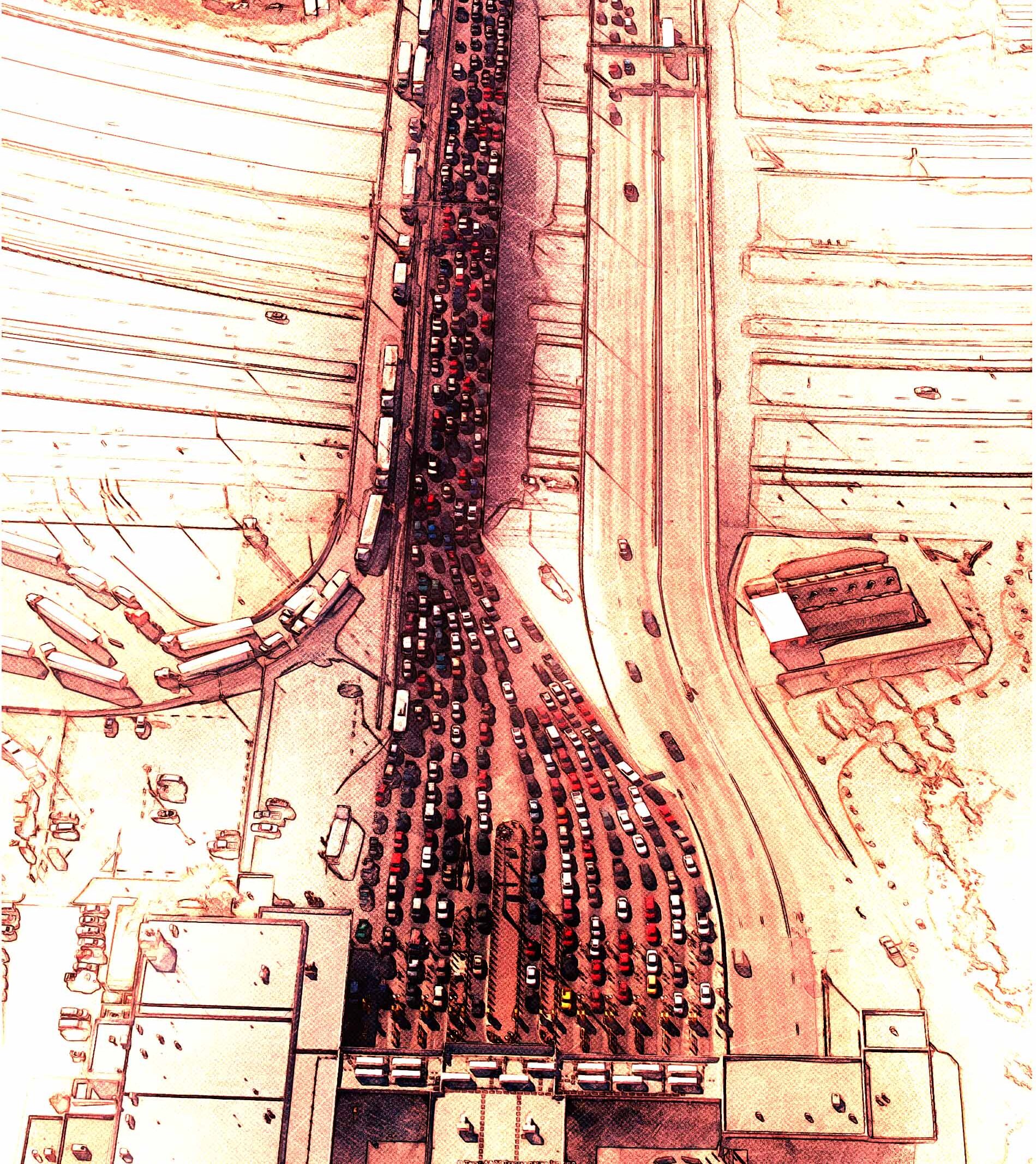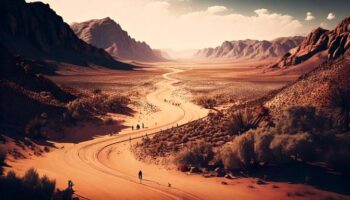“Music is a sound, a sound that surrounds us, whether we are inside or outside the concert halls” —John Cage
The interest of this web text is delimited in the Soundscapes of the border bridges that connect Ciudad Juárez and El Paso. As a product of engineering and technology, bridges can be considered as inexhaustible sources of sound production. The daily dynamic remains active 24 hours a day, seven days a week. Every single day, people cross borders to carry out their daily activities, such as work, study, shopping, negotiate, visit, or just for a hobby, both on one side and the other.
As for those who cross into the United States, the wait to cross the border is variable, for those of us familiar with this daily activity we know that the time depends on the objectives that CBP officers have in the first place. Then it influences both the flow of traffic and the seasons of the main holidays or seasonal offers such as Black Friday. So the waiting time varies between ten minutes and approximately three hours, although there is a record of much longer waiting times. In the different acoustic ecologies of the border bridges the users produce sounds from flow, whether by car or on foot, the environment is affected by the sound emission of each individual, in combination with other elements of the acoustic ecology product of the interaction of people, aesthetic and rhetorical exchanges that axiologically cognitively modify the user.
Border bridges as acoustic ecologies
Schafer says that an Acoustic ecology is, therefore, the study of sounds in relationship to life and society (Schafer, 1977). In this social dynamic, sounds are transformed into codes to which human beings are exposed. Our ears collect a vast amount of sound sources that are recorded in our memory, which allows us to recognize artifacts, places, people, and animals only by the sense of listening. The relationship of sounds in an acoustic ecology builds our experience in relation to the environment. Although the visual sense is more prevalent in most people, it is no wonder why we overlook the omnipresence of sound. Talk radio, ambient music, mobile device alerts, animal and human voices, and random noise all combine to form a sonic backdrop with which we interact with our media ecologies (Boyle, 2017). Following DeChaine, (2012) the figure of the border animates the language of social relations in the United States today. Symbolic and material, affective and performative, the border is an omnipresent force in our everyday lives, materializing and shifting across registers of geography, history, politics, economics, citizenship, identity, and culture.
The border connection between Ciudad Juarez and El Paso is given through different of six bridges near the area. Those that are adjacent are the Paso del Norte International Bridge, the Zaragoza-Ysleta International Bridge, the Córdova-Americas Bridge, and the Lerdo International Bridge. As for the Córdoba-Americas bridge, the inhabitants of the region call it the “free bridge,” because the crossing from north to south is completely free, unlike the other bridges that require a fee to cross, likewise, to cross from south to north the Lerdo International Bridge is required a special permit called “express line,” which not all users can acquire, in the Zaragoza-Ysleta International Bridge there is also a line similar to this, although it offers both modalities, basic fee and express Mainly these bridges constitute the daily life of the borderlands, although there are those who use other bridges somewhat removed from the urban spot. The closest is the San Jerónimo-Santa Teresa International Bridge, although, with the demographic growth of both cities, the remoteness of this bridge is no longer appreciated as it was some years ago. At least ten years ago, using this bridge was like traveling. Road miles mixed with the vast desert towards the horizon. For its part, the Guadalupe-Tornillo International Bridge is the furthest from the area and joins the town of Guadalupe Bravo District with Tornillo Texas, a somewhat agricultural and livestock area.
Although we from Juarez know that the San Jerónimo-Santa Teresa International Bridge is the favorite of people who come from the state capital of Chihuahua, because they cross to the tranquility of El Paso Texas, without mixing with “La Raza Juarense” or “La Chusma.” Although for a juarense this really is not an offense, since at the end of it all we find all together in El Paso, in some Walmart, Target, Ross, or any store where they can stock up on clothing, footwear, and electronic items. The people of Chihuahua easily distinguish themselves, people of Chihuahua, they are regularly seen well dressed, although somewhat exaggerated, the ladies look like the fashion actresses of a Mexican soap opera, and the gentlemen like the fashion gallant, well-combined colors out of a catalog from Dillards or Macys. I do not say that we do not dress well from Juarenses or look presentable, however, going to El Paso is part of our daily lives, waiting on the bridge for as long as necessary, is our pilgrimage.
I must clarify that I have never had a bad experience crossing the bridge, most of the time they have treated me well when crossing, although once I had a somewhat strong conversation with a CBP officer, he asked me: where are they going? I replied: shopping, so he asked me: what will you buy ?, I said: a soda. The reality was that I wanted a Mountain Dew Baja Blast soda. With an ironic tone, he told me that he was Cuban and that, in his country, acquiring a soda was a luxury, he entered his booth and took out a Coca-Cola, pointing to it he told me, do you know how many people want a soda like this in Cuba? I expressed that I had a vague idea, for things I had read and friends who had traveled to their country. He said: no, you have no idea. Then tell me, I expressed. What the agent wanted to tell me is that we Mexicans do not take care of our economy by spending money in the United States and that crossing a simple soda contributed to that big mistake. Although in part I gave him the reason, my reason was that this type of soda is not sold in Ciudad Juarez, he pointed out a Coca-Cola, but I wanted a Mountain Dew Baja Blast. At the end of all his questions, claims, and personal stories, I could understand his positionality, but he was unable to understand mine. My mother says that a few days after I was born I already crossed to El Paso, at first without documents, so I can say that I was an undocumented baby, a few months later they demanded Form-13 and my mother was one of those people who They got up early on the bridge waiting for that document to legally cross. From there, I crossed and crossed how many times they took me, whether shopping, to visit family, to parties of friends of my parents, to walk, to the zoo, to the mountains, etc. What I am trying to say is that, for me, El Paso is essentially like my house, so perhaps for that reason, many of the border workers do not realize the economic factors to which the officer was referring, but it is more than anything because El Paso is not a foreign city for us, it is part of us. The crossing is part of our culture. After a long talk, he let me pass with the warning of taking care of my origins, although he left me thinking for a while when I took a sip of my Mountain Dew I said: this is what we are. This is in addition to many things that constantly unite us on both sides of the border.
The bridges I frequently use are the Cordova-Americas Bridge, the Zaragoza-Ysleta International Bridge, and the Paso del Norte International Bridge, in that order of hierarchy. The International Bridge Lerdo does not use it because I do not have the “express line.” Before approaching the edge, I review the report of bridges in sources of information available on the web. I check the data and visualize the cameras live to give me an idea of the waiting time. Hopefully, I wait between ten minutes to half an hour, if not, I wait between an hour to two. With not so much luck, I wait between three to five hours.
One day, I intended to arrive at the University of Texas at El Paso, where I am a Ph.D. student, to attend a class. For that, I gave myself about two and a half hours before class time to arrive “in time.” My surprise was to find a bridge not very crowded, so I thought it was that lucky day that I could wait at least, half an hour. However, something related to the issue of migrants who are based in Ciudad Juarez awaiting political asylum from the United States happened. My expectation of half an hour was transformed into five hours. Of course, there were moments of frustration because once you’re on the bridge, it’s almost impossible to get out of line to return. Then I had to wait and fortunately, I dedicated my time to listening to the sounds of the bridge and that is how this theme came about.
In these border bridges, different elements make up their acoustic ecology:
• Cars (engines, brakes, and horns)
• Passersby
• Street sellers
• Car wipers guy for both windshield and bodywork
• Pedigüeños
• Musicians
• Helicopters
• Communication radios
• The panting of safety dogs
• Detector alarms
• Birds
• Flagpoles
Bridges Soundscapes
Sonic Border Commuter Experience
Soundscapes Composition







